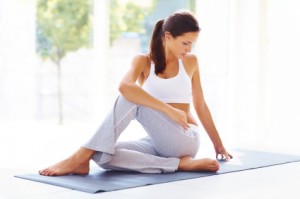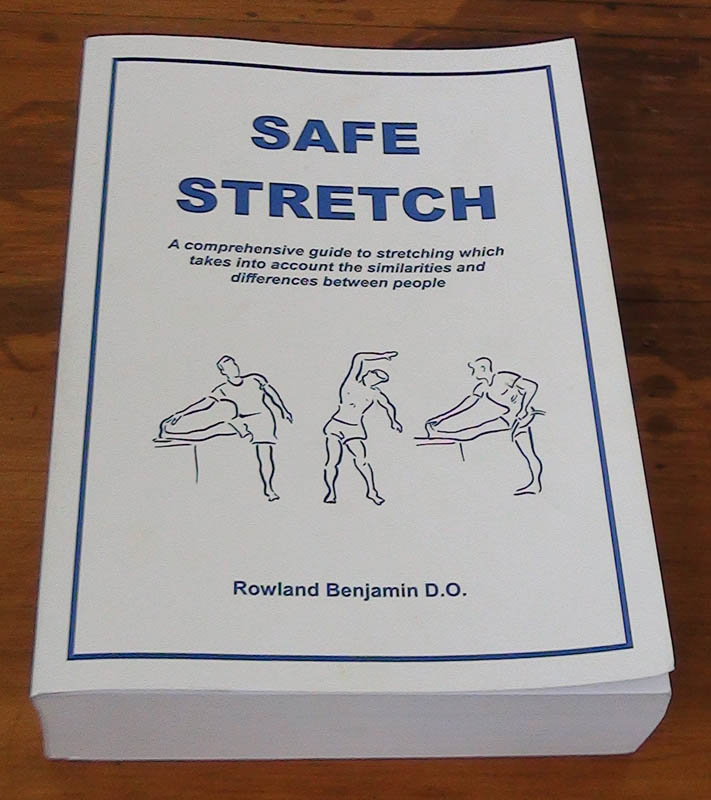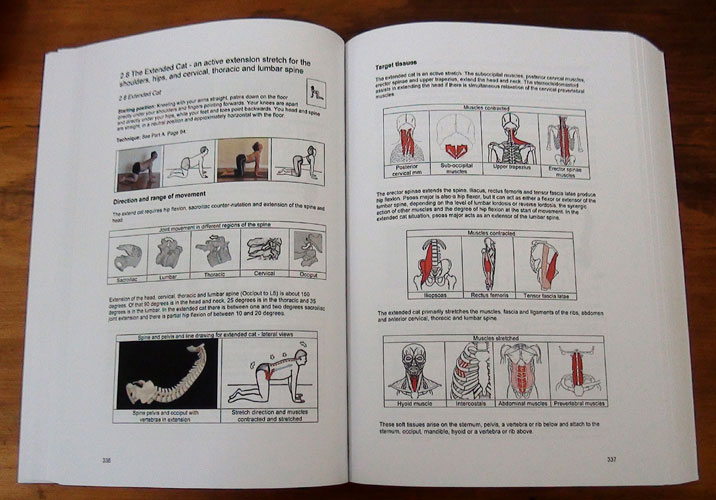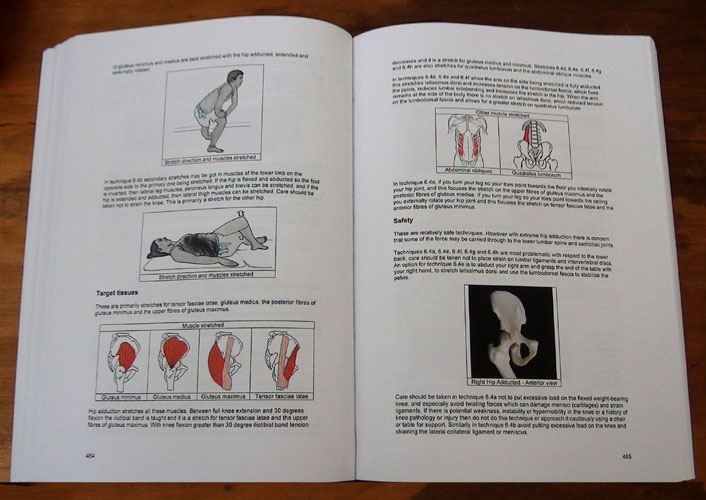Contents

Preface
Why this book has been written?
Who is this book written for?
Icons explained
Biography
Acknowledgments
Introduction
Theoretical considerations
Benefits of stretching
Problems with stretching
Individual differences
Genetic factors
Body types
Gender
Race
Ligament elasticity
Considerations for body type
Other genetic factors
Lifestyle
The mind and mental health
Localised or generalised stiffness
Ageing
Age related stiffness and hypermobility
Posture
Gravity and posture
Genes and posture
Curvatures of the spine
Lifestyle factors influencing posture
Effects of good or bad posture
Solutions
The Universal posture
Flexibility, mobility and stability
Mobility and flexibility testing
Joint mobilisation
Mild versus strong stretching
Active versus passive stretching
Hypermobility and hypomobility
Types of Flexibility
Stability and flexibility
Other factors limiting range of movement
Types of stretches
Medical conditions and stretching
Joint degeneration and mobility
Osteoarthritis
Central canal stenosis
Spondylolisthesis
Over activity and under activity.
 Practical aspects of stretching
Practical aspects of stretching
How to use this book
Is stretching safe?
Props used in stretching
The floor, a chair, a wall, a rolled towel
Daily consideration when stretching
Warming up in the morning
Evening stretching
Stretches for different situations
Food
Stretching routine
The order of stretching muscles
Pain during stretching
Other tissues affected by stretching
Muscle pain after exercise
Injury
The barrier concept
Biomechanical factors
Force and speed
Levers
Gravity
Optimal stretching
Speed and duration measured as breaths
Breathing
Anger and stretching
The focus during the stretch
Localised stretches versus complex stretches
Active, passive and post-isometric systems
Post-isometric stretches
What is the best way to begin stretching?
Injuries
Overstretching
Rest
What should you stretch?
Know your body
Posture
Stretching solutions
Other exercise systems
How is stretching different from Yoga?
Stretching in sport and exercise
Stretching classes
The effect of stretching on muscle strength
Stretching the spine
Overuse patterns
Therapist controlled passive stretching
How long does stretching work?
Localisation
Neuroplasticity and stretching
Learning a skill
Use patterns affecting the brain
Feedback
Causes of poor spinal feedback
Complexity of skill and coding
Private tuition compared with group classes
Activities and lifestyle affect structure,
Factors affecting structure and flexibility
Lengthening – temporary or long term
Ligament laxity
Overstretching
Ligament laxity from one or several events
 Part A. Technique
Part A. Technique
Chapter | Name, type of stretch & areas stretched | Technique name & position
1.1 The Lion – active stretches for the face, tongue, jaw, shoulders, cervical and
thoracic spine (three techniques)
1.2 The Shrug – an active, post-isometric and passive stretch for the face, jaw,
shoulders, arms and hands
1.3 Chin tuck – active stretches for the suboccipital, cervical and upper thoracic spine (three techniques)
1.4 Neck flexion stretches – active, passive and post-isometric flexion stretches for
the suboccipital, posterior cervical and upper thoracic spine (three techniques)
1.5 Neck extension stretch – an active and passive extension stretch for the cervical,
upper thoracic and suboccipital spine
1.6 Neck rotation stretch – an active rotation stretch for the suboccipital, cervical and
upper thoracic spine
1.7 Neck sidebending stretches – active, passive and isometric sidebending stretches
for the suboccipital, cervical and upper thoracic spine and shoulders (nine techniques)
1.8 Sternocleidomastoid stretch – an active stretch for the sternocleidomastoid and
the cervical spine
1.9 Atlanto-occipital post-isometric stretch
2.0 Chair supported thoracic, lumbar and hip active sidebending stretches
2.1 Wall supported thoracic, lumbar and hip passive and post-isometric
sidebending stretches (three techniques)
2.2 Thoracic and rib active sidebending stretches
2.3 Kneeling active lateral stretch for the shoulder, trunk and hip
2.4 Hanging stretches – passive and post-isometric stretches for latissimus dorsi, the
thoracolumbar fascia, quadratus lumborum and the lateral fibres of erector spinea (four techniques)
2.5 Upper Dog – active extension stretches for the shoulders, thoracic and lumbar spine (three techniques)
2.6 The Cobra – active and passive extension stretches for the shoulders, cervical,
thoracic, lumbar spine and hips (four techniques)
2.7 The Locust – active stretches for the shoulders, thoracic, lumbar spine and hips (three techniques)
2.8 The Extended Cat – an active extension stretch for the shoulders, hips, and
cervical, thoracic and lumbar spine
2.9 The Flexed Cat – active flexion stretches for the shoulders, hips, and cervical,
thoracic and lumbar spine
3.0 Knees to chest – active, passive and post-isometric flexion stretches for the
lower thoracic, lumbar and hips (five techniques)
3.1 Spinal twist sitting – active and passive rotation stretches for the shoulders and
the cervical, thoracic and lumbar spine (three techniques)
3.2 Spinal twist standing – active and passive rotation stretches for the shoulders and
the cervical, thoracic and lumbar spine and hips
3.3 Spinal twist standing flexed at the hips – active rotation stretch, for the shoulders
and the thoracic and lumbar spine
3.4 Spinal twist kneeling – active rotation stretch for the shoulders and spine
3.5 Spinal twist prone – active and passive rotation stretches for the shoulders and
the cervical, thoracic and lumbar spine
3.6 Rolled towel – active, post-isometric and passive stretch for pectoralis major,
the ribs, thoracic and cervical spine
3.7 Rolled towel – active, post-isometric and passive stretch for pectoralis major,
the ribs, thoracic and cervical spine
3.7 Longitudinal stretch supine over a rolled towel 111
3.8 Rolled towel – active, passive and post-isometric stretches for the shoulders,
arms, forearms, wrist, hands and fingers (five techniques)
3.9 Rolled towel – active and passive stretches for shoulder, spine, ribs and hip
down one side of the body
4.0 Pectoralis stretches – active, passive and post-isometric stretches for pectoralis
major and other anterior shoulder muscles (eight techniques)
 4.1 Subscapularis stretch – passive and post-isometric stretch for subscapularis
4.1 Subscapularis stretch – passive and post-isometric stretch for subscapularis
4.2 The Drop – passive and post-isometric stretch for the scapula depressor muscles
4.3 Downward shoulder – active stretch for muscles responsible for scapular elevation
4.4 Shoulder abductor front stretch – a passive and post-isometric stretch for the
muscles responsible for shoulder abduction and scapula retraction
4.5 Shoulder abductor behind stretch – passive and post-isometric stretch for the
shoulder abductor muscles
4.6 Palms together above head – active stretch for shoulder muscles and
strengthening technique for muscles of the spine, thighs and legs (two techniques)
4.7 Palms together behind back – active stretch for pectoralis minor, passive stretch for
anterior forearm muscles, wrist and finger flexor muscles and fascia of the hand
4.8 Multiple shoulder muscle stretch – active and passive stretch for shoulder muscles
4.9 Scapula retractor stretches – active, passive and post-isometric stretches for the
shoulder, spine and scapula retractor muscles (five techniques)
5.0 Shoulder external rotator stretches – passive, post-isometric and active stretches
for muscles responsible for shoulder external rotation and scapular retraction
5.1 Shoulder flexor stretches – passive and post-isometric stretches for the
shoulder flexor muscles
5.2 Ledge squat stretches – passive and post-isometric stretches for the anterior
shoulder muscles and fascia (three techniques)
5.3 Elbow flexor stretches – passive and post-isometric stretches for muscles
responsible for forearm flexion
5.4 Triceps stretch – passive stretch for the triceps and muscles responsible
for shoulder adduction
5.5 Supinator stretch – active and post-isometric stretch for the muscles responsible
for forearm supination
5.6 Pronator stretches – active, passive and post-isometric stretches for pronator
teres and pronator quadratus
5.7 Wrist extensor stretches – passive and post-isometric stretches for the extensor
muscles of the wrist and hand (three techniques)
5.8 Wrist flexor stretch – passive and post-isometric stretches for the flexor muscles
of the wrist and hand (five techniques)
5.9 Finger flexor stretch – post-isometric and passive stretch for the forearm, wrist,
hand and fingers
6.0 Iliopsoas stretches – passive and post-isometric stretches for iliacus, psoas and
other hip flexor muscles (three techniques)
6.1 Mixed Gluteus stretches – passive and post-isometric stretches for piriformis
and gluteus minimus, medius and maximus in hip flexion and external rotation (three techniques)
6.2 Hip external rotator stretches – passive and post-isometric stretches for the
hip external rotators and abductors (three techniques)
6.3 Hip internal rotator stretch – active, passive and post-isometric stretches for
gluteus minimus and anterior fibres of gluteus medius (three techniques)
6.4 Hip abductor stretches – passive and post-isometric stretches for tensor fasciae
latae, gluteus medius, minimus and the upper fibres of gluteus maximus (eight techniques)
6.5 Hip adductor stretches – active, passive and post-isometric stretches for the hip
adductors, extensors and internal rotators (14 techniques)
6.6 Quadriceps stretch – active and passive stretches for the quadriceps, tibialis
anterior and the toe extensor muscles (six techniques)
6.7 Hamstring stretches – active, passive and post-isometric stretches for
semitendinosus, semimembranosus and biceps femoris (seven techniques)
6.8 Popliteus stretch – active, passive, and post-isometric stretches for popliteus
6.9 The Dog – active, passive and post-isometric stretches for the hamstrings,
gastrocnemius and posterior fascia (three techniques)
7.0 Forward bends – active, passive and post-isometric stretches for the hamstrings, hip
adductors and external rotators and gastrocnemius and strengthening trunk muscles (four techniques)
7.1 Calf stretches – active, passive and post-isometric stretches for gastrocnemius,
soleus and other posterior leg muscles including peroneus longus and brevis,
tibialis posterior, flexor digitorum longus and flexor hallucis longus (eight techniques)
7.2 Tibialis anterior stretches – active and passive stretches for tibialis anterior and
the toe extensor muscles
7.3 Foot and toe stretches – passive and post-isometric stretches for the long and
short foot and toe muscles (four techniques)
7.4 Hip and back stretches – active, passive and post-isometric stretches for the
hamstrings, piriformis, gluteus medius & maximus, abdominal and lumbar muscles (three techniques)
7.5 Squats – active stretches and strengthening exercises for the whole body
7.6 Pelvic tilt – active stretch for posterior muscles of the lumbar and cervical spine and
strengthening exercise for the abdomen
8.1 Nerve stretches (five techniques)
Part B. Anatomy, Biomechanics and Safety
Direction, Range of Movement, Target tissues, Variations, Safety, Vulnerable areas & Key
Chapter | Name | Type of stretch & areas stretched
Techniques 1.1 – 7.6
The mechanics of stretching
Musculoskeletal system
Terminology, Connective tissue, Structure, Function, Collagens, Deformation of collagen
Elastin, Ligaments, Tendons 528
Tendons compared with ligaments, Fasciae 529
Practical considerations 530
Muscle Structure 531
Function 532
Fast and slow fibres 533
Stretching muscle 535
Biomechanical mechanisms Passive tension
Active tension 536
Neurological mechanism
Post isometric theory 537
Gross anatomy
Anatomy of the head, face and jaw (1.1 – 1.2) 538
Anatomy of the suboccipital and cervical spine (1.3 – 1.9) 543
Anatomy of the ribs, thoracic, lumbar and sacroiliac spine (2.0 – 3.9) 556
Anatomy of the shoulder: scapula, clavicle and humerus (4.0 – 5.2) 571
Anatomy of the elbow and forearm: humerus, radius and ulna (5.3 – 5.6) 585
Anatomy of the wrist and hand: radius, ulna, carpal, metacarpal & phalanges (5.7 – 5.9) 594
Anatomy of the hip: sacrum, ilium and femur (6.0 – 7.0) 600
Anatomy of the knee: femur, tibial and fibula (6.6 – 7.1) 614
Anatomy of the ankle and foot: tibia, fibula, tarsals, metatarsals & phalanges (7.1 – 7.3) 622
Superficial muscles of the body – anterior and posterior views 632
Part C. Stretching routines and combinations
Regional tables – stretches in numerical order and based primarily on anatomical region
Head, face, jaw, occiput and cervical spine 633
Thoracic, lumbar and sacroiliac spine 635
Shoulder, elbow, arm, forearm, wrist, hand and fingers 639
Hip and thigh 645
Knee and leg 649
Ankle, foot and toes 651
Movement tables – stretches based primarily on direction of movement
Head and upper cervical movement 653
Anterior occiput
Posterior occiput
Face and jaw
Head and cervical movement 654
Cervical rotation with sidebending (rotation is primary movement)
Cervical sidebending with rotation (sidebending is primary movement)
Cervical flexion
Cervical extension
Thoracic and lumbar movement 655
Upper thoracic sidebending with rotation
All thoracic sidebending with rotation
Thoracolumbar and lumbar sidebending
Longitudinal sidebending 656
Upper thoracic flexion
Mid or all thoracic flexion
Lumbar or thoracolumbar flexion
Thoracolumbar and lumbar rotation
Upper thoracic extension 657
Mid thoracic extension
Lumbar or thoracolumbar extension 658
Sacroiliac movement
Sacral nutation / flexion / anterior rotation or posterior iliac rotation
Sacral counter nutation / extension / posterior rotation or anterior iliac rotation
Upper and lower limb movement s
Scapula retraction 659
Scapula elevation
Scapula protraction 660
Scapula depression
Shoulder extension
Shoulder flexion 661
Shoulder abduction
Shoulder external rotation
Shoulder internal rotation
Shoulder adduction and horizontal adduction 662
Shoulder horizontal abduction
Elbow extension
Elbow flexion 663
Forearm pronation
Forearm supination
Wrist flexion
Wrist extension
Wrist abduction
Wrist adduction
Finger flexion
Finger extension and abduction
Hip flexion 664
Hip extension
Hip adduction
Hip horizontal adduction
Hip abduction 665
Hip internal rotation
Hip external rotation
Hip and thoracolumbar sidebending 666
Knee extension
Knee flexion 667
Ankle dorsiflexion
Ankle plantarflexion
Foot inversion
Foot eversion
Toe extension
Toe flexion
Stretching programs
Day stretches for pain
Low back pain 668
Neck and shoulder pain
Tension headaches
Wrist pain
Rotator cuff pain 669
Calcaneal spurs
Day stretches for pregnancy
Day stretches for gym exercises
Squats 670
Jumping jacks
Calf raises
Push-ups 671
Dips
Sit-ups, crunches and curl-ups 672
Pull-ups
Day stretches for musicians
Guitar 673
Violin
Cello 674
Piano
Drums 675
Singing
Wind instruments
Day stretches for workers and professionals
Boilermaker Welder 676
Carpenter
Carpet layer and Tilers
Cleaners
Computer Gamer
Cook 677
Counsellor Psychotherapist
Dentist
Electrician
Fine Artist
Gaming, Cards and Board Games
Gardener Landscaper
Hairdresser 678
Jeweller
Knitting
Masseur and Manual Therapist
Mechanic
Painter and Decorator
Plasterer
Plumber 679
Receptionist using telephone
Salesperson and Shop Assistant
Seamstress, Tailor and Sewing
Waiter and Waitresses
Criteria to determine which muscles need to be stretched 680
Weekly stretching programs for sports and other activities
Abseiling 682
Aerobics classes 684
Archery 686
Arm wrestling 688
Batting (cricket baseball) 690
Bodyboarding / boogieboarding 692
Bowling underarm 694
Boxing and martial arts punching 696
Catching a ball (baseball, cricket, rounders and softball) 698
Climbing 700
Cricket (overarm bowling) 702
Cue sports (pool, snooker and billiards) 704
Cycling 706
Dancing (freeform – pop, disco and techno) 708
Dancing (partner – waltz, foxtrot, quickstep and tango) 710
Darts 712
Domestic work 714
Driving a car or truck 716
Easy stretching program 718
Fencing (thrusting and lunging) 720
Golf 722
Hard stretching program 724
Manual labour 726
High jump 728
Hockey 730
Horse riding 732
Ice skating 734
Juggling 736
Kicking a ball (soccer and football) 738
Long jump 741
Motorcycle riding 743
Polo 746 Rowing 748
Sedentary work sitting in a chair 750
Supreme stretches suggested by the author 753
Skateboarding 754
Skydiving 756
Tennis 758
Throwing 760
Volleyball 762
Walking, running and sprinting 764
Windsurfing 767
Whole body flexibility suitable for ballet, gymnastics and wrestling 768
Appendix
Joint ranges of movement 769
Table of anatomical movements 774
Tables of muscle actions 776
Glossary 783
Bibliography and References 796



